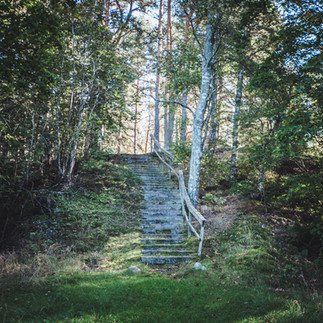HIKING THROUGH TIME: BADELUNDAÅSEN AND ANUNDSHÖG
- Forest Junkie

- Sep 25
- 3 min read
Updated: Sep 28
Where: Västerås, Västmanland
When: All year round
What: Badelundaåsen & Anundshög
What I love about hiking in Sweden is when the woods surprise me with history. Huge boulders left by glaciers, old overgrown mine shafts hidden in the trees, an old car in the middle of the forest taken over by nature—and sometimes, tracks of old paths that have carried people for centuries. Walking such paths like Badelundaåsen and Anundshög, I think of all the souls who’ve walked there before me: travelers, traders, kings... That feeling—that I’m part of something much bigger—never gets old.

THE RIDGE THAT CARVED THE LANDSCAPE
Long before Västerås spread out toward Mälaren, its roots were up on a ridge. After the last Ice Age, when glaciers retreated, they left behind ridges—higher ground made of sand, gravel and bedrock. One of the most important is Badelundaåsen. This ridge (ås in Swedish) runs roughly from Siljan in Dalarna, down south through central Sweden, toward Nyköping. Because it stands a little higher, it stayed drier and more stable—a natural route when much of the land was swampy, muddy, or forest-dense.
Walking parts of Badelundaåsen today means stepping along a natural highway of centuries. Along its length, signs tell of old burial mounds, mines, stone settings, cholera graveyards, gullies from prehistoric horsemen and ancient graves marked with heavy monoliths.

ANUNDSHÖG
Then comes the high point of the ridge: Anundshög. I can’t resist the little word joke, sorry for that. It is Sweden’s largest ancient tumulus (in Swedish gravhög), about nine metres high, some sixty-something metres in diameter—the biggest you’ll find. It dates to the Iron Age—or possibly late Iron Age. Some findings under the mound (a fireplace) are radiocarbon dated between about AD 210-540.
Surrounding the main mound are many other monuments—smaller burial mounds, stone circles, several ship-settings, standing stones. These mark ritual spaces, burial grounds, meeting points. In the medieval period, Anundshög was more than ritual. Archaeologists have found remains of a tingshus (thing-house) in use in the late Middle Ages. A thing-house is a gathering place for law, dispute resolution and local governance. There is also evidence for a stolprad—rows of wooden posts that might have marked communal or sacred spaces. Some wood fragments suggest parts of such structures go back to ~300 AD.
You're free to walk around the historic area and you can climb the burial mound using the stairs. Recently (May 2025), over 50 illegal pits were discovered in and around stone-ship areas, a stark reminder that history is fragile.
RUNESTONE AND ERIKSGATA
There’s a runestone here too, known as Vs 13. Created by a man named Folkvid for his son Heden, the brother of Anund, the stone’s inscription is more than just names carved in ancient runes—it’s a message of grief, remembrance, and social status. Historians don’t know exactly all the details—why exactly here, or who exactly was meant to see it—but runestones often marked borders, memory lines, and even power. The runestone is part of a long line of raised stones thought to follow the Eriksgata, the king’s route, a symbolic path across lands that new kings traveled so they could be acknowledged by people.
LABYRINTH
Across the road from the main mound, the ridge keeps going, and there are more surprises: a smaller tumulus, more ancient gullies and an ancient labyrinth at Tibble made with thousands of stones, probably connected to spring rites. No one is certain what rituals happened there.

THE ROOTS OF VÄSTERÅS
Västerås itself owes much to this ridge and Anundshög. Centuries ago, the settlement and power were up high—on more defensible, drier ground. But trade, transport, and especially access to water eventually pulled life toward Lake Mälaren. Boats, commerce, shipping mattered. So the city moved closer to the lake, to where goods and people could move more easily. Anundshög stayed behind as a symbol, a memory in stone.
Sometimes, standing by the large mound of Anundshög, I lay my hand on a stone. I wonder whose hands touched it centuries ago—what they looked like, what they saw, what storms they weathered. And I think: I’m one more person in the long chain of those who came before. That’s the magic of this ridge and its history.
HELPFUL LINKS:
Anundshög's website:
Badelundaåsen map:
Information from the province of Västmanland (+ video) visitvastmanland.com/upptack-anundshog-och-badelundaasen



















































Comments